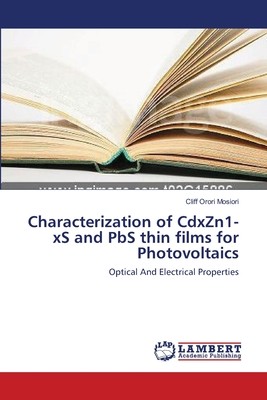
- We will send in 10–14 business days.
- Author: Cliff Orori Mosiori
- Publisher: LAP Lambert Academic Publishing
- ISBN-10: 3659414034
- ISBN-13: 9783659414039
- Format: 15.2 x 22.9 x 0.7 cm, softcover
- Language: English
- SAVE -10% with code: EXTRA
Characterization of CdxZn1-xS and PbS thin films for Photovoltaics (e-book) (used book) | bookbook.eu
Reviews
Description
A study of CdZnS and PbS nano-crystalline thin films deposited by chemical bath deposition (CBD) method has been made using Four point probe for electrical sheet resistivity, UV-Vis spectroscopy and solar simulator for optical and Photovoltaic cell properties respectively. Sheet resistivity for CdZnS thin films was found to decrease as the concentration of Zn increased while PbS thin films had their sheet resistivity increase with increase in bath concentrations. Optical band gap for CdZnS had a tunability depending on the various Zn2+ concentrations used successfully as demonstrated by UV-VIS-NIR spectroscopy. Transmittance in CdxZn1-xS was found to be above 80%, optical band gap of 2.47 - 2.72 eV, refractive index of 2.58 - 2.39, and sheet resistivity of 1.09 - 1.36 Ã 102 Ω-cm for x = 1.0 - 0.6. The thin films were suitable for use as window films for optical devices. PbS films were good absorbers with a band gap of 0.88 eV and transmittance below 55%, Electrical resistivity varying from 6.78 Ã 103 to 1.26 Ã 104 Ω-cm, conductivity of 1.09 Ã 10-4 to 7.9 Ã 10-5 S-cm-1. The PbS films were suitable as absorber films for photovoltaic cell applications.
EXTRA 10 % discount with code: EXTRA
The promotion ends in 19d.10:24:24
The discount code is valid when purchasing from 10 €. Discounts do not stack.
- Author: Cliff Orori Mosiori
- Publisher: LAP Lambert Academic Publishing
- ISBN-10: 3659414034
- ISBN-13: 9783659414039
- Format: 15.2 x 22.9 x 0.7 cm, softcover
- Language: English English
A study of CdZnS and PbS nano-crystalline thin films deposited by chemical bath deposition (CBD) method has been made using Four point probe for electrical sheet resistivity, UV-Vis spectroscopy and solar simulator for optical and Photovoltaic cell properties respectively. Sheet resistivity for CdZnS thin films was found to decrease as the concentration of Zn increased while PbS thin films had their sheet resistivity increase with increase in bath concentrations. Optical band gap for CdZnS had a tunability depending on the various Zn2+ concentrations used successfully as demonstrated by UV-VIS-NIR spectroscopy. Transmittance in CdxZn1-xS was found to be above 80%, optical band gap of 2.47 - 2.72 eV, refractive index of 2.58 - 2.39, and sheet resistivity of 1.09 - 1.36 Ã 102 Ω-cm for x = 1.0 - 0.6. The thin films were suitable for use as window films for optical devices. PbS films were good absorbers with a band gap of 0.88 eV and transmittance below 55%, Electrical resistivity varying from 6.78 Ã 103 to 1.26 Ã 104 Ω-cm, conductivity of 1.09 Ã 10-4 to 7.9 Ã 10-5 S-cm-1. The PbS films were suitable as absorber films for photovoltaic cell applications.


Reviews